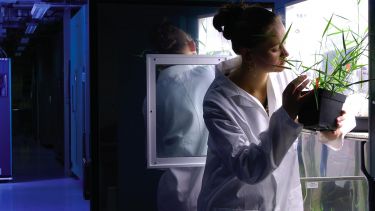Theme 2 – Fundamental crop weathering science
This theme utilises controlled environment facilities to explain mechanisms and genetic controls on weathering by major warm climate crops to accelerate development of new weathering varieties that maximise carbon capture and protection against pests and diseases, reducing pesticide usage and costs.

Maize
Maize is the most widely grown cereal crop in the world. We are exploiting genetic variation in maize to study the relationship between silicate rock weathering and silicon-induced protection against key pests and diseases.
In addition to examining within-plant mechanisms of silicon-induced resistance, we are investigating the contribution of the rhizosphere microbiome to weathering and disease suppression.
Part of this work focuses on the role of specific secondary metabolites in root exudates that recruit plant-beneficial soil microbes. Identified varieties will be field-trialled at the Energy Farm, Illinois (Theme 3).
Rice
Rice accumulates silica which promotes cell wall strengthening and defence priming, both key control points for infection and molecular resistance against the parasitic weed Striga. Striga causes devastating losses of yields of rain-fed rice, maize, sorghum and millet in sub Saharan Africa, costing the African economy over 7 billion US$ annually.
The aim of this programme is development of new faster weathering varieties of rain-fed rice with enhanced resistance to Striga as a low cost and sustainable control strategy for resource poor farmers in Africa that helps to improve food security whilst contributing to climate change mitigation.
We are exploiting newly-available rice genetic resources developed by Dr Lorieux to rapidly map QTL and identify genes controlling weathering of silicate rocks and silica accumulation by rice.
Single column reactor studies
We are using mesocosm-scale single-column reactors with specific crop functional types in agricultural soils, and employing mesh bag approaches, to investigate grain-size dependent weathering mechanisms at the molecular scale and overall efficiency. These studies are being complemented with abiotic incubation rock grain dissolution studies for validating models (Theme 1).
We are focusing on sorghum and soybean as key crops forming symbiotic microbial partnerships with mycorrhizal fungi and nitrogen-fixing rhizobia, respectively.
Experiments with single column rock weathering reactors allows development of detailed elemental budgets and physico-chemical characterisation of soils and rock grains using a diverse range of advanced techniques, including XRF, XRD, SEM-EDX and BET, sequential extraction methods and synchrotron based spectroscopic and microtomography studies.
This work serves to illustrate the fate of the applied rock grains in soils under crop cultivation systems.
















